Hildegard of Bingen
… man flies with the two wings of rationality, that is to say, with the knowledge of good and evil. The right wing is good knowledge and the left, evil. Evil knowledge serves the good, and good knowledge is kept in check by the evil, and is even made more discerning by it. Indeed the good is made wise in all things through the evil.
Extract of letter from Hildegard to the Monk Guibert
The twelfth century nun, Hildegard of Bingen (1098- 1179), grew up in a Benedictine monastery, left there by her parents at the age of eight, and by all accounts had a pretty miserable time. When she was about thirty-eight, Hildegard owned up to having 'visions' sent from God. She experienced the visions from when she was a small child, but had kept them secret: '…for fear of the scepticism of others, the shrugging of shoulders, and the manifold gossip of mankind…' Spurred on by encouragement from the eminent intellectual heavyweight of the day, Bernard of Clairvaux, and subsequently by Papal approval, Hildegard dictated descriptions of her visions to her faithful scribe and secretary, the monk, Volmar, and throughout the rest of her life, Hildegard produced a substantial and fascinating body of work ranging from music to medicine to cosmology and God.
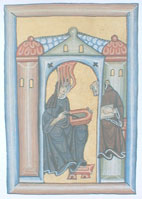
Hildegard dictates her visions, emanating like flames from above, to the monk, Volmar. Liber Scivias, copy of the former Rupertsberg Codex, c. 1180; St Hildegard's Abbey, Eibingen
Hildegard became known as the Seer, the Prophetess of the Rhine. Miracles and healing were attributed to her and her community was famous throughout Europe. She had correspondents all over the continent, whom she chastised and encouraged, nurtured and cajoled; her letters betray a fierce, a fiery and a gentle character. The first of her books, Scivias, or the Know the Way, took ten years to write. Subsequently, among others, came the Book of Divine Works and Physica, as well as a series of song cycles for voice and musical instrument, The Play of the Virtues and The Symphony of the Harmony of Celestial Revelations. Despite her prolific output, however, Hildegard always professed to be an illiterate and uneducated woman. She maintained that her understanding of medical and cosmological matters, as well as the way of life that the nuns in her community followed, were directly inspired by visions from God.
Subsequently, the image of Hildegard has been used as a screen for devotional projections by the left and right and points in between. A procession to mark the 750th anniversary of her death, near the site of her original community in Bingen, in 1929, for example, was rumoured to have attracted 25,000 people. On the other hand, according to a contemporary American born nun who lived within the community at Eibingen that Hildegard created for over a quarter of a century, 'Everybody started reading Hildegard' because of the interest stimulated by the ex-Dominican, Matthew Fox: '…they all wanted to make her their own, the esoteric and the New Agers, the feminists, the ecologists and what have you. They all said, "She's our woman." We said Hildegard's task was different.'
I'm not sure when I first got interested in Hildegard. I have a postcard of one of her images, titled Universe, that sits on my desk in front of my computer. It's sitting there now, as I write. It has been there for years, robustly radiating mystery. I had always found it very calming and centring. I still do and I still don't really know why because in some ways it's quite a disturbing image. Its got little gargoyles who are all very busy vomiting up bits of heaven; eggs, or pellets, that seem to be on fire; slugs secreting body fluids.
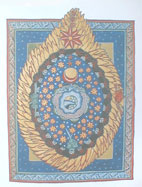
The Universe Liber Scivias
When I was asked to write a paper for a conference on 'The State of the Real' at Glasgow School of Art, I thought that this would be a good time to look at Hildegard's images more closely. Hildegard herself was for many years reluctant to admit to the 'reality' of her visions. And yet, as I was able to discover on studying them, each image provides a brilliantly concise, evocative and beautiful précis of twelfth century natural philosophy. What I offer below is my interpretation of three of Hildegard's images, beginning with a new improved interpretation of what, in my original ignorance, I thought in Universe were snails and radiated frogspawn.
In the centre of Universe is a spherical world. It's packed with shapes and colours that represent the elements. The egg shapes stand for the element of earth; gold represents fire; the darkness denotes ether; and the dash of blue and white represents a mixture of water and air. Surrounding the circular world is a billowing cloud of blue and white. This likewise represents a kind of watery air. It was thought in Medieval and earlier Aristotelian cosmology that the heavens were filled with liquid, and this is Hildegard's simple visual rendition of the idea. Around the billowing cloud are the strange snail shapes. In fact these shells protect the lower earth from the fire of heaven, as well as helping to direct the winds. The small grim belching faces personify the force of the wind itself. Surrounding the earth are the fixed stars and the Moon, shown both in its waxing and waning state. Directly above the Moon are the two inner planets, shown as slightly larger stars, Mercury and Venus. Around the rim of the fixed stars is a dark area, again representing ether. Interspersed through the ether are heaps of egg-shapes with radiating flames. These denote the element of earth, or matter, connected by fire to the outermost part of heaven, the primum mobile. Here, in this outermost region are the Sun and the outer planets, Mars, Jupiter and Saturn, shown as large stars. One of the unusual aspects of this mandala-like picture is the absence of an obvious image of God. Only the flames piercing out of the very frame of the picture point to a numinous dimension. But like all of Hildegard's images it represents a vision of the unified and dynamic connection of every constituent of matter.
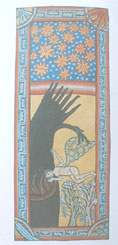
The Fall Liber Scivias
The image above, from Hildegard's Scivias, represents the Fall. At the corners are images to represent air, fire, earth and water. The border is made of a repeated motif of the winds blowing in opposite directions. This is to suggest the sense of dynamism and movement in the scene. Elsewhere Hildegard talks about the idea of the winds pushing and pulling, creating dynamism. The upper part is devoted to planets and stars in a blue heaven. Air and fire, or the sun, act downwards from the heavens; water and earth are below, at the level of the earth. A large black serpent, like smoke, rising from an earthy cauldron of flames at the very base of the picture, rises up and pierces the sky. Meanwhile Adam, levitating horizontal above flowering trees - the Garden of Eden - cups his hand to his ear as he listens to the roaring flames of the inferno below. He is midway between heaven and earth. The flames themselves, to which he is listening, are in diagonal opposition to the benevolent flames of the sun in the top right hand corner of the picture. From Adam's rib, sprouts a cloud of stars. This is Hildegard's un-bodied image of Eve, the Mother of All Living. The stars of Eve, shooting out of Adam, reflect the stars of the sky. They also make a pun on the idea of Stella maris, a name of Mary, star of the sea, the sea of heaven. Reiterating the piercing of the sky, the serpent pierces the cloud of stars with a triple pronged tongue. The image is both sexual as well as referring to speech. The active serpent speaks while the passive Adam listens. But there is also a subtle symbiosis in the serpent and Adam's relationship. The serpent's smoky emanations pierce into the lower level of the sky; in the meantime, Adam's head pierces the side of the serpent, his hand stretching out along the level of its neck. If you turn the whole image on its head, it looks as though Adam is simultaneously being crushed by the weight of the serpent while he is also actually holding him up. The picture is very finely balanced. But you also wonder what on earth was going on in Hildegard's head!
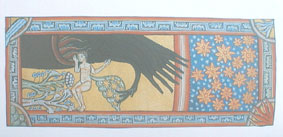
Hildegard said of her visions:
'…The visions which I saw I did not perceive in dreams nor when asleep nor in a delirium nor with the eyes or ears of the body. I received them when I was awake and looking around with a clear mind, with the inner eyes and ears, in open places according to the will of God….'
In a letter to a monk who befriended her, she said:
'…my perception of things depends on the shifting of the clouds and other elements of creation. Still I do not hear these things with bodily ears, nor do I see them with the cogitations of my heart or the evidence of my five senses. I see them only in my spirit, with my eyes wide open…'
The neurologist, Dr Oliver Sacks, following on from the historian of science, Charles Singer, who first mooted the idea in 1917, has suggested that Hildegard's visions were the result of migraine. It is recorded that Hildegard suffered from debilitating diseases from an early age. For Sacks, Hildegard's 'splendid and beautiful' stars become: '… a shower of phosphenes [tiny sparks common in the early stages of migraine] in transit across the visual field, their passage succeeded by a negative scotoma'.

The Head of God Liber Scivias
He suggests that her images of the City of God represent migrainous 'fortifications', a common pixellated disturbance of the visual field. He describes her 'Head of God', as depicting a 'typically migrainous fortification figure…radiating from a central point, which…is brilliantly luminous and coloured'. That Hildegard may or may not have suffered from migraine, and whether or not we can believe her when she says that she was an uneducated woman, her writings belie a pretty comprehensive knowledge of the important texts of the day.
Her Scivias, or Know the Way and Physica show knowledge of the medical writings of Galen, Pliny, Isidore of Seville, as well as references to Augustine and the physics and cosmology of Aristotle. The two communities she founded - of around twenty nuns following the Benedictine rule - one at Rupertsberg, and one at Eibingen, near Mainz, were very close to the great libraries and centres of scholarship, Worms, Metz and Triers. Hildegard's 'Head of God', it seems to me, is a complex image of the Trinity and of the relationship of God to humanity. In the lower left, three rows of battlements rise in a diagonal to meet the awesome un-bodied face in the centre. Rising from the face to the upper right, is a single solid plane in gold. The lower battlements, I think, signify the world and the diversity of man's creation, while the crenellations of the upper plane become like Jacob's Ladder, visually leading the eye out of the frame. The two constituents of the image meet, unify and transform within the Head of God itself. The three wings radiating from the Head optically reiterate the idea of three separate elements being unified into one structure. One wing pierces the frame of the picture: to show that God can break all boundaries.
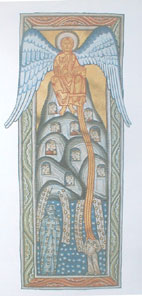
The God of Illumination Liber Scivias
In another of the images from Scivias, the wings of the Creator God pierce the frame. The image is in three parts. At the top is a golden image of the Divine. In the centre is a mountain with people. At the bottom, on an abstract background of stars, are two conceptual figures. In the bottom left is an apocalyptic figure which we know from the text is called 'Fear of the Lord'. This tall figure, giving a key to the picture as a whole, is covered in a pattern of eyes. It is an image of illumination, of vision. The great Illuminator is on the top of the mountain, which itself is covered with a pattern of apertures in which are revealed the faces of people watching the spectacle that unfolds before their eyes, like so many little television sets. A river of gold runs down from the figure on the mountain to cover the head, eyes, ears, mouth and all, of the figure at the bottom right of the picture. This is an image of a little girl, called 'Poverty of Spirit'. The idea is that the senses should be filled up with an image of the divine. It recalls Dante's idea that the vision of angels is contiguous with the image of God.
From the first moment these beings found their bliss
Within God's face in which all is revealed,
They never turned their eyes away from It;
Hence no new object interrupts their sight
And hence, they have no need of memory
Since they do not possess divided thought.
Dante, trans. Mark Musa, Paradise (USA: Penguin Classics, 1986), 29, 76-82.
I was surprised when I saw this image of the golden stream connecting the three levels of the world, the divine, the earthly and the inner workings of mankind, as it appears to me that a version of the image has persisted. An image of 'A Young Girl with Hair raised to Heaven' appears in the work of an Italian philosopher called Giulio Camillo (1480?-1544). Camillo interpreted the image as meaning vigorous, strong or trustworthy. Anecdotally, I heard recently of a woman who has recently had a similar vision of hair streaming up to the heavens. Perhaps there is something archetypal about this striking image, something real and dynamic to which Hildegard was attuned.
Further Reading on Hildegard
Baird, Joseph L. & Ehrman, Radd K., trans. The Letters of Hildegard of Bingen, (Oxford University Press, 1998)
Bowie, Fiona & Davies, Oliver, eds. Hildegard of Bingen, (London: SPCK, 1990)
Burnett, Charles, Kraye, Jill & Ryan, W.F., eds. Hildegard of Bingen, The Context of her Thought and Art, (London: The Warburg Institute, 1998)
Maddocks, Fiona, Hildegard of Bingen, (London: Headline, 2001)
Sacks, Oliver, Migraine, (London: Picador, 1995)
Schipperges, Heinrich, trans. John Cumming, The World of Hildegard of Bingen, (Tunbridge Wells: Burns & Oates, 1998)
Singer, Charles, From Magic to Science, Essays on the Scientific Twilight, (London: Benn, 1928)
Warner, Marina, Monuments and Maidens, (London: Weidenfeld & Nicholson, 1985)
